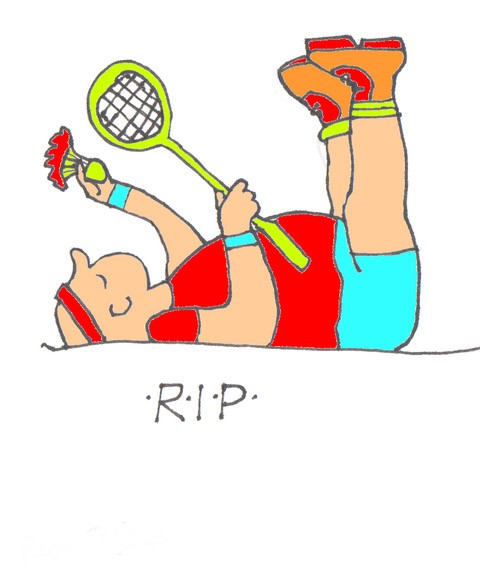Complications of exercise Part 1
Complications of Exercise
‘The only exercise I take is acting as pall-bearer to my friends who have indulged in strenuous exercise!’ Mark Twain
Despite Mark Twain’s jaundiced view, exercise is extremely safe. Even strenuous and prolonged exercise rarely produces more than muscle or joint strains and sprains. Not exercising is far more dangerous than exercising. However no physical activity can be entirely free from risk. This Blog starts with the most significant (also the rarest) complication of exercise – and then works backwards.
Sudden death
The best-known, but also the rarest complication of exercise is literally dropping dead. The incidence is about one per 50,000 in professional athletes in whom the usual cause is a congenital abnormality of the heart. Sudden death is nearly always caused by a disturbance of heart rhythm known as ventricular fibrillation (VF). This is an electrical accident in which the muscle fibres of the main heart chambers, the ventricles, lose their rhythmic coordinated control, Consequently each muscle fibre contracts and relaxes independently of all the other fibres. As a result, the ventricles stop pumping and death follows swiftly if normal heart rhythm is not restored.
Definitive treatment is ‘defibrillation’ which is the application of an electric shock to the victim’s chest which stops the heart. The heart usually then restarts with the individual fibres contracting together – cardiac output is thus restored. If a defibrillator is not immediately available, the victim can be kept alive by external cardiac massage until one can be acquired. Automatic external defibrillators (AEDs) are carried by all emergency ambulances and by many ‘first responders’. They are also widely available in community facilities and public places. It is not unreasonable for all concerned citizens to learn how to perform external cardiac massage and acquaint themselves with the way to use an AED. The instructions for their use make it easy enough to allow completely untrained individuals to apply the defibrillation successfully. St John Ambulance Brigades offer resuscitation courses across the country.
Hypertrophic cardiomyopathy
The most common cause of VF in young people is a congenital abnormality of the heart – hypertrophic cardiomyopathy (HCM). This is inherited as an autosomal dominant gene, which means that on average half the offspring of a sufferer will have the condition. All the children of HCM patients should be screened. If found to be positive, they will usually be fitted with an implanted defibrillator which delivers a defibrillating shock if the heart goes into VF.
It has been suggested that all professional sports people should be screened for HCM. Unfortunately, screening has a high false negative rate – six out of eight in one study of sudden death in young footballers had previously had normal screening results. So screening is generally not thought to be a cost-effective endeavour and may also lead to a range of psychological, ethical and legal problems.
Coronary heart disease
In middle and later life sudden death from VF is usually caused by coronary heart disease, either at the onset of a heart attack or as a result of severe heart damage from previous heart attacks. There is a widespread belief that sudden death from a heart attack is a result of ‘massive’ cardiac damage. In fact, VF at the onset of a heart attack is an electrical accident unrelated to the extent of cardiac injury. Those who are successfully resuscitated have the same prognosis as those who have not suffered this complication.
VF can be triggered by exercise – the rate of VF during competitive sports is about one per 130,000 person years, during triathlons about one per 60,000 mostly during the swimming section,and during marathon running about one per 50,000. The risk of exercise-related VF in fit exercisers is far lower than in unfit non-exercisers. When the risk of sudden death during exercise is compared with the benefits of being a regular exerciser, the regular exerciser is by far the less susceptible. There is always a small risk with vigorous exercise, but the reduction in the death rate resulting from being physically fit easily outweighs the dangers of vigorous exercise.
Are you signed up?
If you are a visitor and want to sign up to receive the blog each week, click here:
https://mailchi.mp/e4f0caea4029/exercise-fitness-health-blog
Buy my book!

You can order a copy of my latest book here! This is directly through me for £12.50 and includes P&P.
Subscribe to the blog
Categories
- Accelerometer
- Alzheimer's disease
- Blood pressure
- BMI
- Cancer
- Complications
- Coronary disease
- Cycling
- Dementia
- Diabetes
- Events
- Evidence
- Exercise promotion
- Frailty
- Healthspan
- Hearty News
- Hypertension
- Ill effects
- Infections
- Lifespan
- Lipids
- Lung disease
- Mental health
- Mental health
- Muscles
- Obesity
- Osteoporosis
- Oxygen uptake
- Parkinson's Disease
- Physical activity
- Physical fitness
- Pregnancy
- Running
- Sedentary behaviour
- Strength training
- Stroke
- Uncategorized
- Walking


